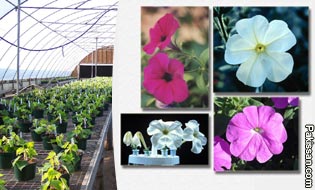|
Main Page
|
![]() |
Issues, challenges and opportunities in floriculture
By Adnan Younis
THE flower industry
comprises cultivation and trade of cut flowers, cut
foliage, potted plants and bedding plants. The main
representatives of cut flowers are: the rose,
chrysanthemum, gladiolus, carnation and lilies.
 Potted
plants and cut flowers have an almost 80 per cent share
of the world trade in ornamental plant products. In the
flower industry, significant changes are occurring in
competitive relationships worldwide. Potted
plants and cut flowers have an almost 80 per cent share
of the world trade in ornamental plant products. In the
flower industry, significant changes are occurring in
competitive relationships worldwide.
A number of traditional markets are displaying signs of
saturation and at the same time new markets are
developing in some parts of the world. It is expected
that per capita consumption and production will go up
worldwide. There is a dilemma in obtaining clear insight
into the prospects for the floriculture industry. In
almost every country in the world there is some florist
industry but in many countries the available figures are
not accurate.
Pakistan is a country of small farming households where
floriculture is one of the best options for enhancing
the income of under privileged. Introduction of
floriculture crops could be an important intervention in
this regard where a farmer can earn much more by
exploiting the available natural resources.
We have favourable climate and cheap labour for growing
these crops, whereas they need much less land and water
for production. These crops also give premium prices
almost round the year and there is no need to wait for a
long time as in the case of other routine crops. Net
profit against the investment is much higher from these
compared with other conventional crops. The products are
in high demand all over the world.
Floriculture in the country is in embryonic stage. There
are lack of resources and skilled persons to develop the
industry up to international standards. It is the need
of the time to produce skilled personals and explore new
means to ensure survival of our farmers and explore
marketing to save our economy as well as increases
export.
The value added products from non-conventional
floricultural crops like essential oil of rose, tube
rose, jasmine etc., and plants extracts used in
medicines and pharmaceutical industry are unique and
likely to face less competition in international market
after the post WTO scenario and thus have the potential
for export and import substitution.
The Northern Areas have very rich flora and germplasm
which still is not exposed. The available natural
resources can be exploited commercially. Marketing of
cut flowers is unorganized. In most cities, with large
market potential, flowers are brought to wholesales
markets, which mostly operate in open yards.
A few flower merchants generally buy most of the produce
and distribute them to local retail outlets after
significant mark-up. The retail florist shops usually
operate on roadsides with little or no protection for
flowers. It is the need of time that the government
should invest in setting up auction centres, as well as
organize floral shops with better storage facilities to
prolong vase life of cut flowers.
The production issues which hampers growth of this
industry are lack of required seed, flowers, germplasm
and tissue culture facilities; lack of technological
assistance; shortage of capital investment; shortage of
trained manpower; poor post-harvest management; and lack
of pest and disease control.
The marketing issue are the limited airfreight space;
lack of proper cold chain; lack of regional and
international cooperation; patenting, royalties, the WTO
laws; and inadequate transport facilities.
The opportunities existing in this business are proper
development of high quality flowers and bulbs for
domestic and overseas markets; marketing of essential
oils and other products like rose hip syrup, jam,
jellies, cosmetics, perfumes and medicines; development
opportunities for native flora for domestic and export
markets both; identification of market niches that can
be supplied taking advantage of the climate; widening of
the networking ability of industry and advantage of
working with key grower groups to increase market
access; and an increase in industry’s access to
skill-based training schemes.
The challenges which the industry faces are that some
popular flower types are over-supplied in international
market; lack of quality and quantity assurance of
products for maintaining market share in export
business; national coordination should be increased to
maximize effective promotion in export markets; and the
non-availability of skilled labour during harvesting.
Export constraints facing the industry are less
encouragement in export of floricultural product with
low performance attributed to constraints like the
non-availability of air space in major airlines, since
most of the airline operators prefer heavy consignments;
insufficient number of flights during peak seasons; fear
of exporters in regard to infrastructural problems such
as bad interior roads, inadequate refrigerated transport
and storage facilities; lack of professional backup of
delivery and supporting companies, which resort into
high cost of technology; and tedious phyto-sanitary
certification and an unorganized domestic market.
The government should reduce import duty on planting
material and equipment; bring down airfreight to a
reasonable level; provide sufficient cargo space in
airlines; establish model nurseries for supplying
genuine planting material; establish cooperative florist
organizations at regional level; set up training centres
for diploma course; provide cold chain from farm to
destination; and should adhere phyto-sanitary conditions
and the WTO laws.
Courtesy: The DAWN |
|
Pakissan.com;
|
|
|